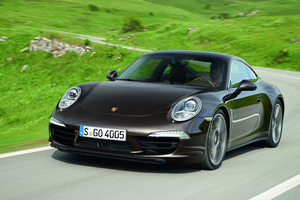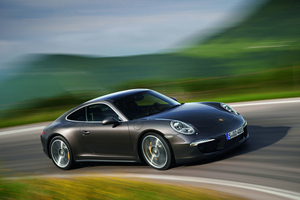|
Send this page to a friend! Fill in the form bellow | ||
news
All-Wheel Drive Porsche Carrera 4, 4S and Convertible Debut
Porsche PorscheGermany, 1931 > present43 models
PorscheGermany, 1931 > present43 models
4639 photos
29 videos
has taken the wraps off of the 991-chassis Carrera 4 Porsche 911 Carrera 4Germany, 2012 > present2 photos
Porsche 911 Carrera 4Germany, 2012 > present2 photos
, Carrera 4S Porsche 911 Carrera 4SGermany, 2012 > present3 photos
Porsche 911 Carrera 4SGermany, 2012 > present3 photos
and Carrera 4 Cabriolet Porsche 911 Carrera 4 Cab...Germany, 2012 > present3 photos
Porsche 911 Carrera 4 Cab...Germany, 2012 > present3 photos
, which like all previous generations offer the Carrera with all-wheel drive. The Carrera 4 all-wheel drive system sends power to the rear in most situations but can deliver it to the front when necessary.
Mechanically, the standard Carrera and Carrera 4 are quite similar. Porsche says that most the body design, suspension, engines and transmissions are identical between the two variants. It is still offered with the 3.5-liter and 3.8-liter flat sixes and seven-speed manual and seven-speed PDK.
The only mechanical change is the all-wheel drive system, and the rear of the car is 22mm wider than the standard car. The rear tires are also 10mm wider than what buyers get on the standard Carrera. Porsche also changed the rear of the car slightly. At the rear there are now a single row of LEDs with the model designation below it.
Compared to the previous generation Carrera 4, the new generation consumes 16% less fuel and is 65kg lighter.
The Carrera 4 Coupe produces 350hp and accelerates to 100km/h in 4.5 seconds or 4.7 seconds for the convertible. It has a top speed of 285km/h or 282km/h. Fuel consumption for the coupe is 8.6l/100km and 203g/km of CO2. The convertible uses 8.7l/100km and produces 205g/km of CO2.
The Carrera 4S Coupe and Convertible produce 400hp. The coupe accelerates to 100km/h in 4.1 seconds and has a 299km/h top speed. It uses 9.1l/100km and emits 215g/km of CO2. The convertible accelerates to 100km/h in 4.3 seconds and has a 296km/h top speed. It uses 9.2l/100km and emits 217g/km of CO2.
Porsche is also rolling out new options of the Carrera 4 that will eventually become available on the standard Carrera as well. The Carrera 4 has an all-wheel drive indicator that shows how much power is going to the front and when. It also gets several options like a glass sunroof, extended Sport Chrono pack, adaptive cruise control, automatic braking for PDK models, and automatic rev matching for manual transmission cars with the Sport Chrono pack.
The new Carrera 4 will make its debut at the Paris Motor Show on September 27. Porsche says that the Carrera 4 cars made up 34% of Carrera sales in the last generation.
The Six Porsche 911 Generations
The first rear-engined 911 was something like a sports upgrade of the Volkswagen Beetle. Over the years it became one of the most successful competition cars and one of the most iconic and influential sports cars in automobile history. The 911 is currently sold in its sixth generation, internally designated 991.
Porsche 911 classic: 1963-1989
The first, 'classic' 911 was launched in 1963 and was conceived as replacement for the Porsche 356. Its initial name was 901 which was changedto 911 later, but remained the first series' code.
Porsche 911/964: 1989-1993
With the 964 series some major developments were made, mechanically or in terms of body design. The first variant from this series was a 4-wheel drive model, the Carrera 4. A year later came the rear-wheel drive Carrera 2. The 964 series were the first 911s available with all-wheel drive and Tiptronic automatic transmission options. By 1993, over 62.000 had been manufactured.
Porsche 911/993: 1993-1997
The 911 returned with a third series in 1993, with the internal code 993. This was the last 911 to use an air-cooled engine. The exterior was completely revised and more aerodynamic. Mechanically the 993 came with a new multilink rear suspension for better ride and handling. Engine capacity remained at 3.6 L, but power rose to 272 PS (200 kW).
Porsche 911/996: 1997-2005
It was a big step for the Porsche 911 after 34 years of production when it finally traded its traditional air-cooled engine for new water-cooled ones. With the ‘996’ internal dub, the 1997 generation of the 911 started being manufactured in 1997 and was sold until the beginning of 2005. Several variants grew from the 996 model, such as the Turbo that debuted in 2000.
Porsche 911/997 Series: 2004-2012
Porsche rejuvenated its 911 sports model again in 2004, with the release of its 997 series. Although mechanically similar to its predecessors, aesthetics diverged from the previous 996 generation. Until 2007, the 997 had become the most successful 911 generation in terms of sales, having sold more than 100.000 units.
Porsche 911/991 Series: Since 2012
Porsche unveiled the latest generation of the 911 at the 2011 Frankfurt Motor Show. It is based on an entirely new platform, the third since the original 911 was first launched. After 48 years the model continues to be unmistakably a 911. Its longer wheelbase, further 100mm, and its lower height, the new 911 continues to show its athletic appearance, retaining the typical sports car compact exterior dimensions.
Encyclopedia | Engine Flat 6 Displacement 232 cu in Top Speed 186 mph Transmission 7, Manual Maximum power 400 hp @ 7400 rpm Type Fixed-head coupé Fuel Petrol Fuel consumption (combined) 23.76 US MPG | price £ 99.734* based on Germany prices annual ownership cost £ 2.548 |
- More "Paris Motor Show" articles
- Paris Motor Show: Hyundai i10 facelift revealed
- Mercedes gunning for the off-road estates
- Alfa Romeo launches new Giulia Veloce
Contribute
more about Porsche



latest news


































